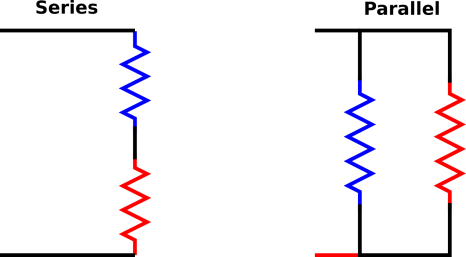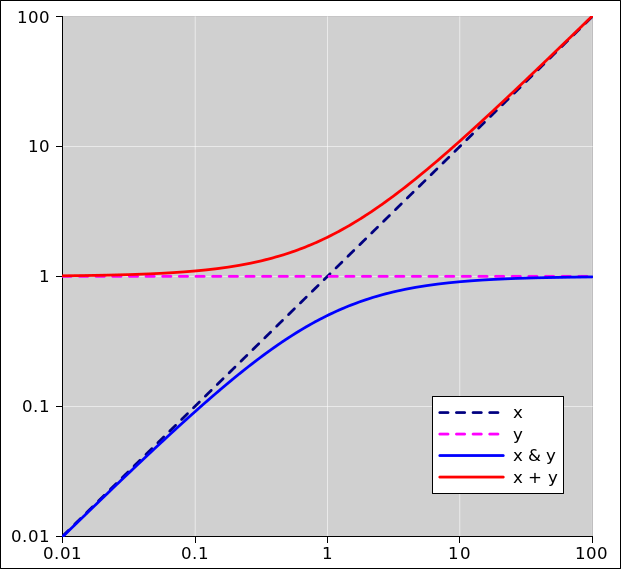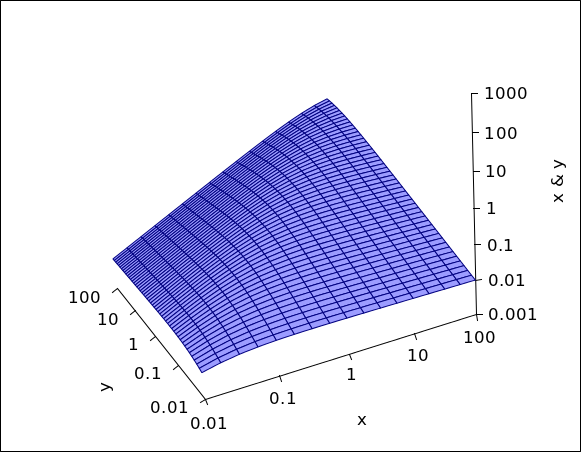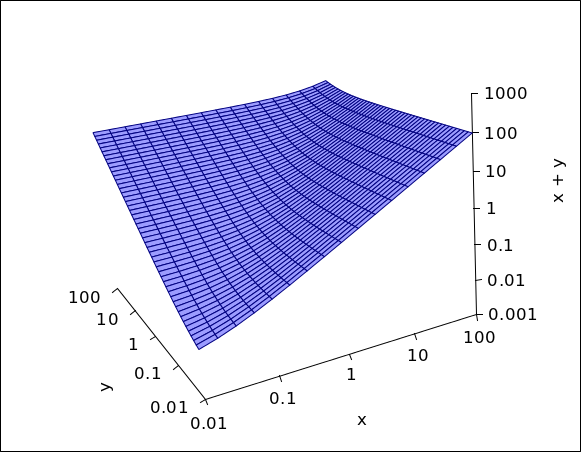For present purposes, we restrict attention to the case where x and y are non-negative real numbers, which is appropriate for ordinary resistors. (The case of negative or complex x and y is also interesting, and is relevant for capacitors and inductors, but let’s leave that for another day.)
| (2) |
which defines InvAd as a function of two variables.
It may be that most of your experience has dealt with functions of one variable, such as sine, cosine, square root, et cetera. Now we have a function of two variables, which is somewhat harder to visualize ... but not unreasonably so, as we shall see.
Then, the next time you encounter it, think about it some more. Figure out some more of the properties. Figure out some more of the connections.
We call this the spiral approach. You begin by learning some bare facts. Then you spiral back and use principles to connect the dots. Then you learn some new facts and spiral back again to connect them to all the previously known facts and principles. And so on.
Here is a scenario that may not apply to you personally, but illustrates the sort of thing I am talking about.
- The first time you see equation 2, you might connect it only to the axioms of algebra, because that’s all you know.
- The next time you see it, in the context of resistors in parallel, you can connect resistors to the equation and to the axioms.
- The next time you see it, you can relate capacitors in series to resistors in parallel and to the equation and to the axioms.
- The next time you see it, you can relate thin lenses to capacitors to resistors to equations to axioms.
- The next time you see it, you can relate De Morgan’s theorem to thin lenses to capacitors to resistors to equations to axioms.
- et cetera.
You may think this section presents more than enough details about the InvAdd function, but actually I have left out more than half of the story. There’s a lot more you can figure out if you want. See e.g. section 3.
You can’t give something a clever name until after you know what it does. Therefore the first time you encounter something, give it a nondescript temporary name, such as F. After you figure out what it does, you can go back and rename it.
| (3) |
The RHS of equation 4b would be ill-behaved if we applied it when x=y=0, but we have nothing to lose by simply defining InvAdd(0,0) to be zero. This is the only reasonable answer, as you can see by setting x equal to y and then taking the limit as they both go to zero.
Equation 4 is equivalent to equation 2 whenever xy is nonzero ... and since equation 4 is well-behaved at zero and equation 2 is not, we have nothing to lose by studying the InvAdd function instead of the InvAd function. So let’s do that.
| We can turn InvAdd into a function of one variable by holding the other variable constant. For example, we can evaluate: | In contrast: |
|
|
| This makes sense in terms of the physics of a resistor in parallel with a dead short. | This makes sense in terms of the physics of a resistor in series with an open circuit. |
| Here is another way of turning InvAdd into a function of a single variable. You can show that: | In contrast: |
|
|
| That tells us that an infinite resistance is the identity element for the InvAdd operator (resistors in parallel). | A zero resistance is the identity element for the addition operator (resistors in series). |
Note that strictly speaking infinity is not a number and in general cannot safely be treated as a number ... but in this narrow context it is OK. A thin lens with infinite focal length is a well-known and harmless concept. Also, infinite resistance is a well-known concept. It can sometimes get you into trouble, e.g. if you hook a constant-current source to an infinite impedance load ... but that is no worse than hooking a constant-voltage source to a zero-impedance load.
| Here’s yet another way of turning our function into a function of a single variable: We can use the same variable twice. That gives us: | In contrast: |
| In other words, InvAdd(x, x) is a straight line with slope 1/2. This has an obvious physical significance in terms of identical resistors in parallel. | In other words, sum(x, x) is a straight line with slope 2. This has an obvious physical significance in terms of identical resistors in series. |
so we already understand a few things about this function.
In this case, we discover that when evaluating InvAdd(x, y), the two input variables need to have the same dimensions; otherwise the denominator in the definition (equation 4) doesn’t make sense.
We also discover that the result returned by InvAdd(x, y) has the same dimensions as x and y. So in this way, InvAdd has something in common with the addition operator: InvAdd(x, y) has the same dimensions as sum(x, y).
The recall process depends on using connections to fish up ideas when they are needed. Therefore the learning process depends on forming appropriate connections. This takes time and effort. Whenever you are exposed to a new idea, you need to mull it over. You need to ponder it, looking for ways in which it is similar – or dissimimlar – to previously-known ideas.
So, in item 12 as well as in item 11 establishing a connection between the InvAdd function and the sum function greatly strengthens our understanding of the InvAdd function ... and even strengthens our understanding of the sum function.
| (11) |
Again: You are allowed to define your own notation.
Learning is not a routine, mechanical process. It is a creative process. See reference 5.
|
|
|||||||||||||||||||||||||||||||||||||||||||||||
| All of these make sense in terms of the physics of resistors in parallel. | All of these make sense in terms of the physics of resistors in series. |
Note that there is no such thing as “the” distributive property, because there are lots of different things that might or might not distribute over other things. Examples include:
- In ordinary arithmetic, multiplication distributes over addition, as in equation 13c.
- Multiplication distributes over InvAdd, as in equation 12c.
- As a counterexample, ordinary addition does not distribute over multiplication.
- In Boolean logic, BooleanAnd distributes over BooleanOr.
- Also in Boolean logic, BooleanOr distributes over BooleanAnd.
See also item 29 for a discussion of a generalized distributive law.
A remark about the process: Again we are making connections, connecting the algebraic properties of the ∥ operator to the physical properties of electronic circuits ... and also to the algebraic properties of the + operator. Obviously ∥ and + are not exactly identical. They are in some ways the same, and in other ways the opposite.
You can easily verify that if we hold y constant, then as x approaches zero,
Similarly, as x becomes large
| We can summarize both equation 14 and equation 16 by saying that when we have N disparate resistors in parallel, the parallel combination is dominated by the smallest resistor in the bunch. | We can summarize both equation 15 and equation 17 by saying that a series combination is dominated by the largest resistor in the bunch. |
| Note that in equation 17, we have convergence in log/log space. The sum itself, without the logs, does not actually converge ... but usually people care more about the ratio, as in equation 18, and log/log convergence is an appropriate way to quantify this. |
You can verify the asymptotic behavior as described in the previous item.
For example, you might wonder whether 1/(1/x + 1/y) could sometimes be approximated by x + y, which would make things nice and simple.
Now it turns out that this is a perfectly terrible approximation. There are many ways that you can tell that x∥y is not “usually” equal to x+y, for instance by looking at item 9 or item 10 or item 11 or item 17 or item 18.
Indeed you can easily prove that x∥y is never equal to x+y for any real-valued x and y, except in the trivial case when x=y=0 or when x=y=∞.
However, as a matter of principle, if you want to be scientific you have to check all the plausible hypotheses. Some of the hypotheses will check out, and some of them won’t. Accepting a hypothesis without checking is just as bad as rejecting a hypothesis without checking.
As a case in point: The topic we are discussing today originally arrived at my desk in the following form: «How do you convince a student in a lasting manner that the reciprocal of (1/x + 1/y) is not, in general, x+y?»
That is a perfectly reasonable question as far as it goes, and is worth answering (see item 19) ... but it is only the tip of the iceberg. Any student who understood expression 1 wouldn’t ever think it was equal to x+y. So we should take an indirect approach: First understand the expression, and then use that understanding to answer the original question.
For this reason, the information we have given about resistors in parallel is of very limited importance. You are likely to forget it, and that’s OK. In contrast, the process of figuring things out is of unlimited importance, because you get to use it again and again. That is something you can and should use every day, which means you will never forget it.
If some day you find that you need to know about resistors in parallel, for instance if you are designing some fancy electronic filter network, you can spend the first five minutes of the day re-learning everything you need to know.
The next day, you will probably need to understand some other formula. As long as you remember the process involved in figuring out such things, all will be well.



